The Boxer is a popular mastiff-type Molosser dog breed in the United States, Germany, and the UK, and one of the top dog breeds in the United States. Different types are depending on the country of origin, colors, and any mixes. However, they all have similar ancestors and temperaments. Read on to learn about different types of boxers dogs and their color.
1. German Boxer
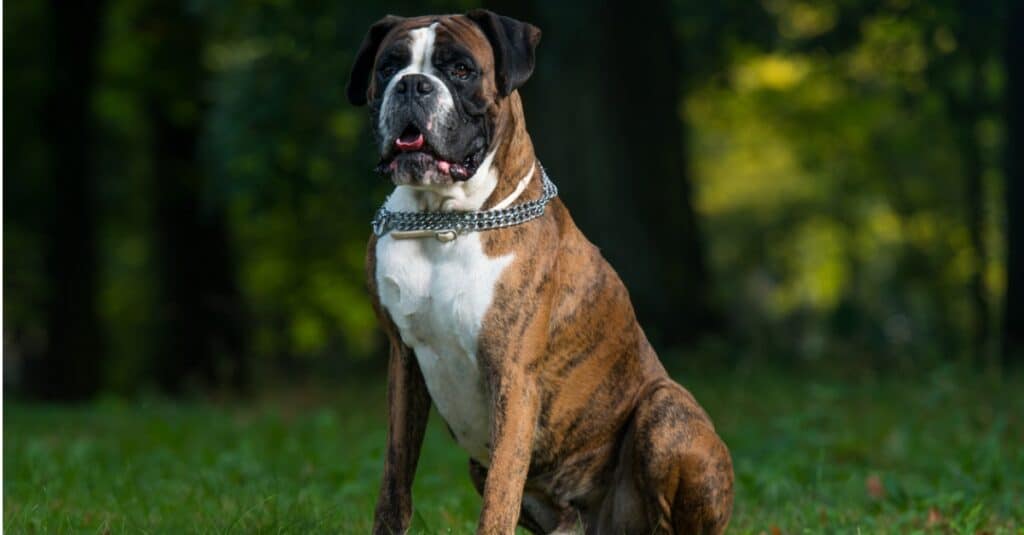
©iStock.com/Ibrakovic
The German boxer or European boxer is a medium to large-sized shorthaired dog. Males have an average height of 22.4 to 24.8 inches and females have an average height of 20.9 and 23.2 inches. Males have an average weight of 66lbs and females have an average weight of 55 pounds. A German boxer puppy weighs between nine to 15 pounds at eight weeks and is considered fully grown between 12 to 18 months of age. It has an average lifespan of nine to 12 years.
The type of boxer was the first, oldest, and what some say is the only “official” boxer dog. It is the largest and stockiest of the three breeds. Originally bred as a guard dog and bull-baiting dog in the 19th century, it later became butcher’s helpers to control cattle in slaughterhouses. It is descended from the English Bulldog, Mastiff, the now-extinct Bullenbeisser or German bulldog, which was a hunting dog, and probably also Great Dane and a terrier. The length between its snout and skull has a ratio of 1:2, which is wider than the English boxer. Fawn and Brindle are the breed standard’s acceptable colors.
2. American Boxer
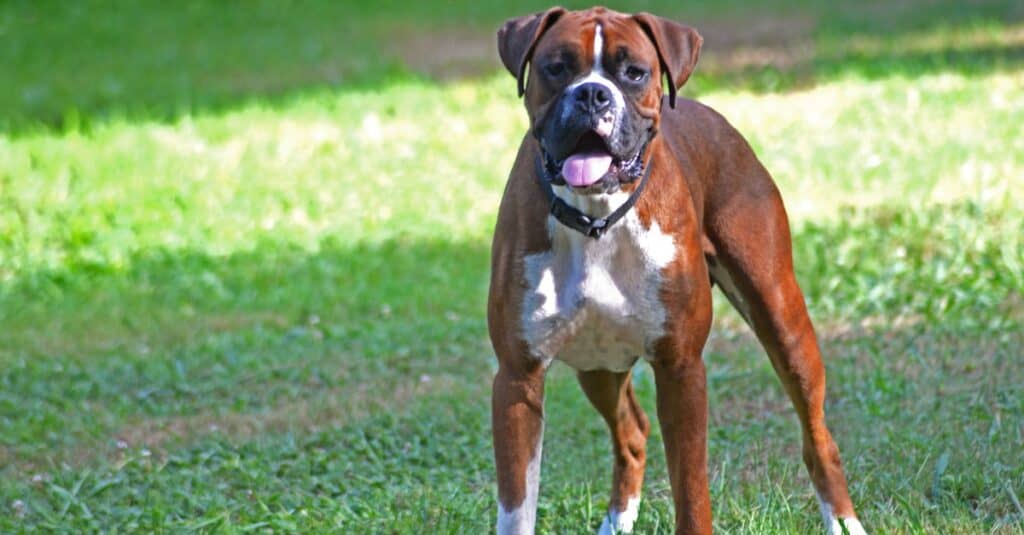
©iStock.com/Betty4240
The American boxer is a medium to large-sized shorthaired dog. Males have an average height of 22 to 25 inches and females have an average height of 21 to 24 inches. Males weigh between 60 to 80 pounds and females weigh 50 to 65 pounds. There can be short and stocky and tall and lean variations. An American boxer puppy weighs between nine to 15 pounds at eights weeks and is considered fully grown between 12 to 18 months of age. It has an average lifespan of nine to 12 years.
The American boxer was registered in 1904. When the American Boxer Club was formed in 1935, the original American boxer had German basic stock with additional German and Austrian imports to create a unique breed standard. It is smaller and leaner than the German boxer and has a snout-to-skull ratio of 1:3, with a snout that is larger than the German boxer. Fawn, Brindle, and Reverse Brindle are the breed standard’s acceptable colors.
3. English Boxer

©Raven Imagery/Shutterstock.com
The English boxer, British boxer, or UK boxer is a medium to large-sized shorthaired dog. Males have an average height of 22.5 to 25 inches and females have an average height of 21 to 23 inches. Males weigh between 66 to 70 pounds and females weigh 55 to 60 pounds. An English boxer puppy weighs between nine to 15 pounds at eight weeks and is considered fully grown between 12 to 18 months of age. It has an average lifespan of nine to 12 years.
The English boxer is the smallest of the boxer breeds and is considered to be the most elegant. Its body is slender, graceful, and athletic, with thinner and shorter legs. It has a snout-to-skull ratio of 1:3 and its snout is thinner than that of the German boxer.
4. Brindle Boxer
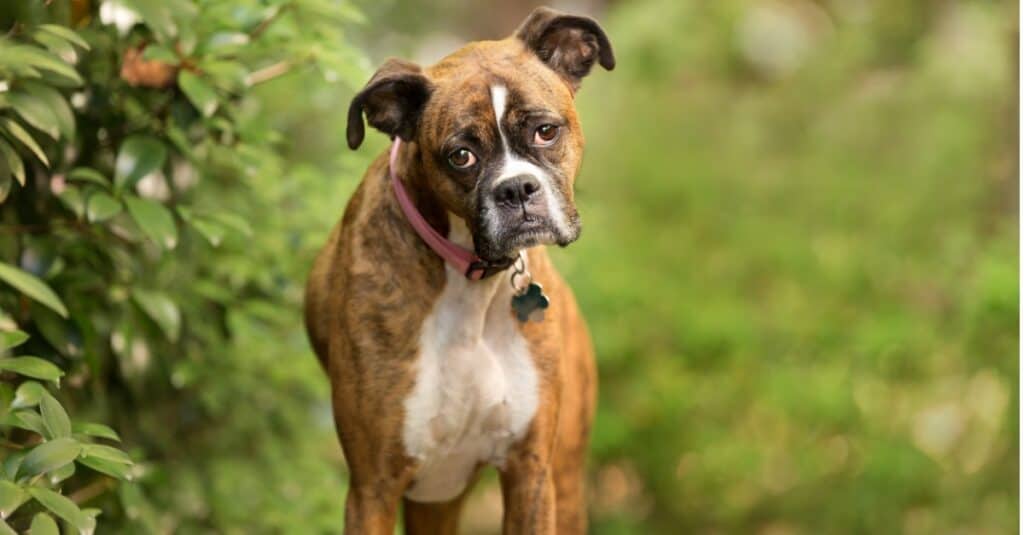
©iStock.com/AprilCarlsonPhotography
Brindle is considered to be one of two original standard colors besides the Fawn. It is a subtle color striping, typically of very dark brown or black on a red base, although purebred boxers can’t produce truly black fur. The brindle-colored dog may have a blue hue or be reddish-brown, similar to the Fawn shade.
Brindle boxers can be classified based on shade and the coat color. The stripes may also be dark or light. Tiger brindle, mahogany brindle, and reverse brindle-these are the three types. Some brindles even have white markings, which are deemed “flashy” brindles.
5. Fawn Boxer
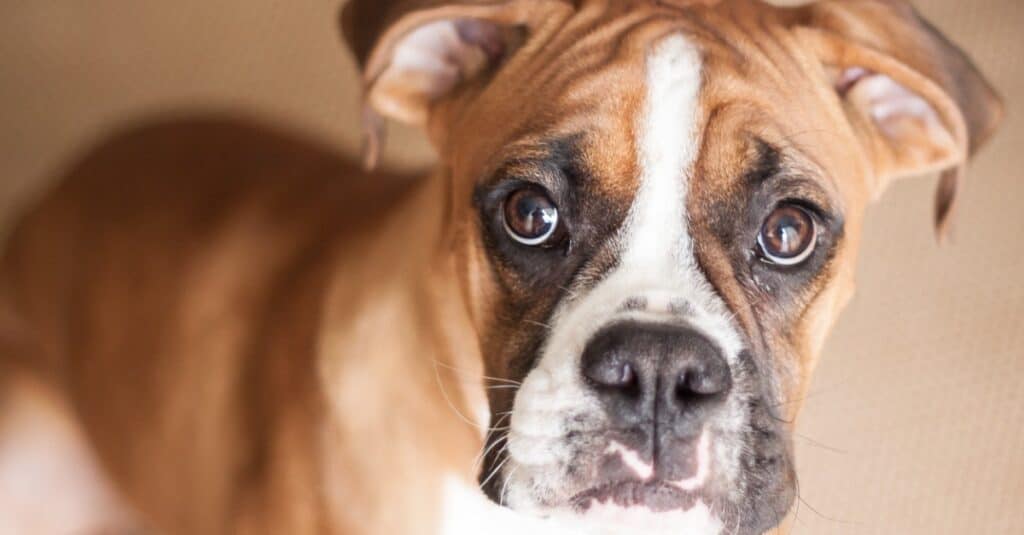
©iStock.com/michael_lofenfeld
Fawn is one of the other original standard colors besides Brindle. Fawn is a reddish-brown color. Some fawn-colored boxers have white markings on their chest and paws so they are known as fawn and white boxers.
6. Reverse Brindle Boxer
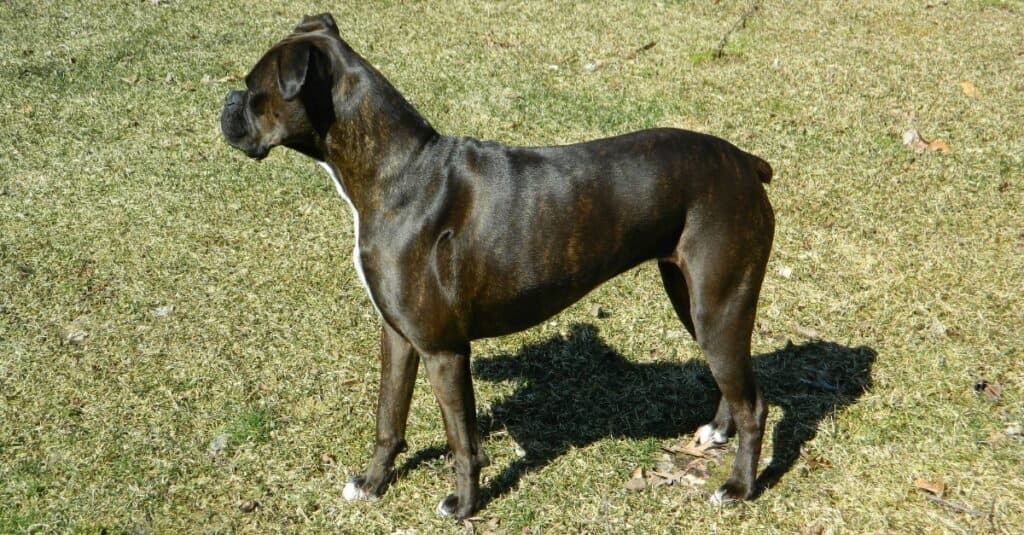
©iStock.com/Richard Paoli
This color of the boxer is advertised as rare. Black is not one of the standard acceptable colors, but it does appear among all three breeds. It’s the appearance of a black color, such as a very dark brown rather than being a true black for boxers. Also called reverse brindle, it is a heavy, dark brindle of very dark brown or fawn brindle on a very dark brown base. The coloring is lighter and more pronounced against the base as opposed to a traditional brindle.
7. White Boxer

©iStock.com/Amanda Woldt Photography
White is not one of the standard acceptable colors, but it does appear among all three breeds. Although some breeders think white boxers have more health problems and are inferior to brindle and fawn boxers, it is a purebred color and might one day be accepted in the AKC.
8. Boxador
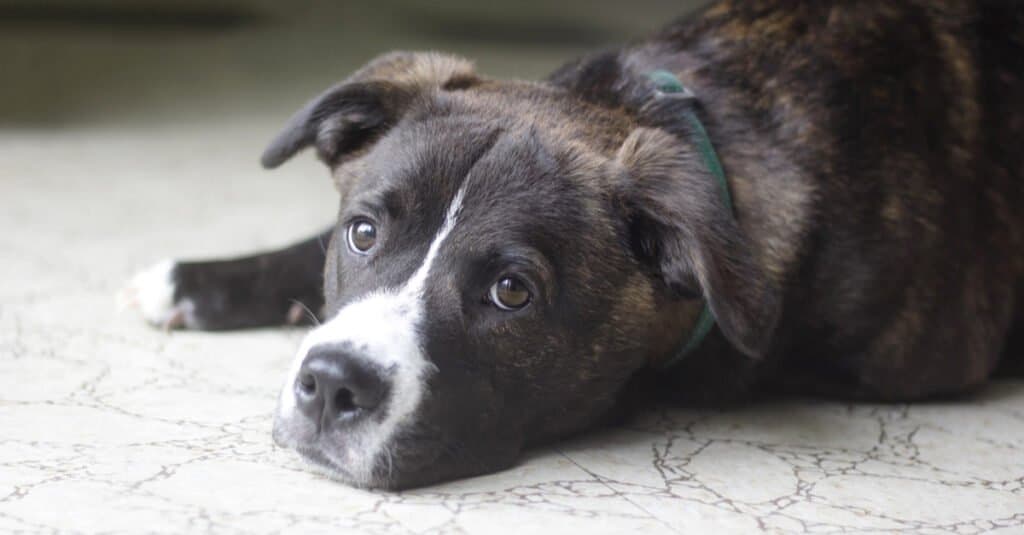
©Ashleycd1/Shutterstock.com
There are several boxer mixes people have created, including some popular hybrids. The Boxador is one of the most common, beloved types of boxer mixes around. This crossbreed inherits a large size from both parents and the unique appearance and personality traits of both, making for a loyal, loving, active, friendly, silly, and people-pleasing dog that gets along with children and other pets. It is also easy to train, although it is prone to separation anxiety. Its lifespan is greater than the purebred boxer with an average of 12 to 15 years.
The Boxer Temperament
Regardless of the different types of boxers dogs, the boxer temperament among all three breeds or bloodlines is energetic, social, affectionate, brave, intelligent, independent, and silly personality. It is however normal for a boxer puppy to be shy or unsure of surroundings due to inexperience. According to the breed standard, aggression towards other dogs is not considered a fault and it is not recommended to have this breed alone or unsupervised with other dogs.
As you can see, there are different types of boxers dogs including the three breeds or bloodlines of American boxer, German boxer, and English boxer, the fawn, brindle, and white colors, and boxer mixes. Although there is just one standard boxer dog breed, there are slight differences between the three and larger differences between the purebreds and the mixes.
How Long Do Boxers Live?
The average lifespan for a boxer is anywhere from 10-12 years old. Cancer is the leading cause of death in this breed, so it is important to look out for symptoms so it can be treated as soon as possible before spreading. Brain tumors are particularly common for boxers, affecting approximately 40% of boxers. Boxer owners are advised to keep their dogs on an active schedule with a nutritious diet containing proteins from real meat in order to assure the healthiest lives possible for their pups.
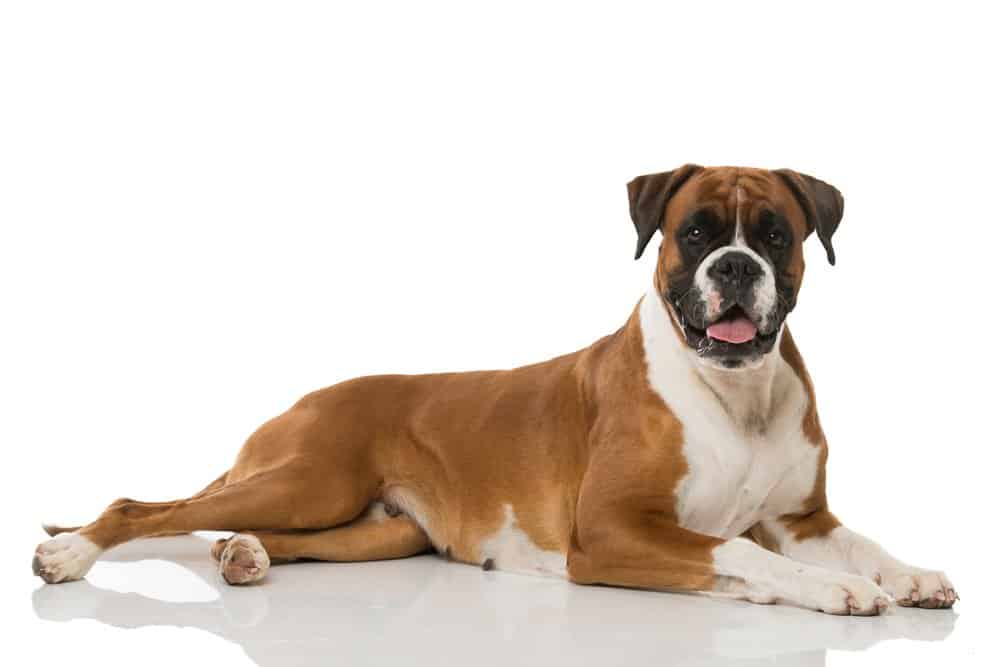
The oldest boxer ever recorded lived to be over 16 years old.
©Dora Zett/Shutterstock.com
Summary of Types of Boxer Dogs
| Types | Description | |
|---|---|---|
| 1 | German Boxer | Oldest, largest, and stockiest of the boxers – brindle or fawn coats |
| 2 | American Boxer | Smaller and leaner than the German boxer – fawn, brindle, and reverse brindle coats |
| 3 | English Boxer | The smallest, most elegant of the boxer breeds |
| 4 | Brindle Boxer | Boxer with a subtle color striping, typically of very dark brown or black on a red base |
| 5 | Fawn Boxer | Fawn is a reddish-brown color that is considered one of the standard colors |
| 6 | Reverse Brindle Boxer | A heavy, dark brindle of very dark brown or fawn brindle on a very dark brown base – considered to be rare |
| 7 | White Boxer | Considered to be a purebred color |
| 8 | Boxador | A cross between a Labrador Retriever and a boxer |
The photo featured at the top of this post is © iStock.com/Annet Oldenkamp
Ready to discover the top 10 cutest dog breeds in the entire world?
How about the fastest dogs, the largest dogs and those that are -- quite frankly -- just the kindest dogs on the planet? Each day, AZ Animals sends out lists just like this to our thousands of email subscribers. And the best part? It's FREE. Join today by entering your email below.
Thank you for reading! Have some feedback for us? Contact the AZ Animals editorial team.







